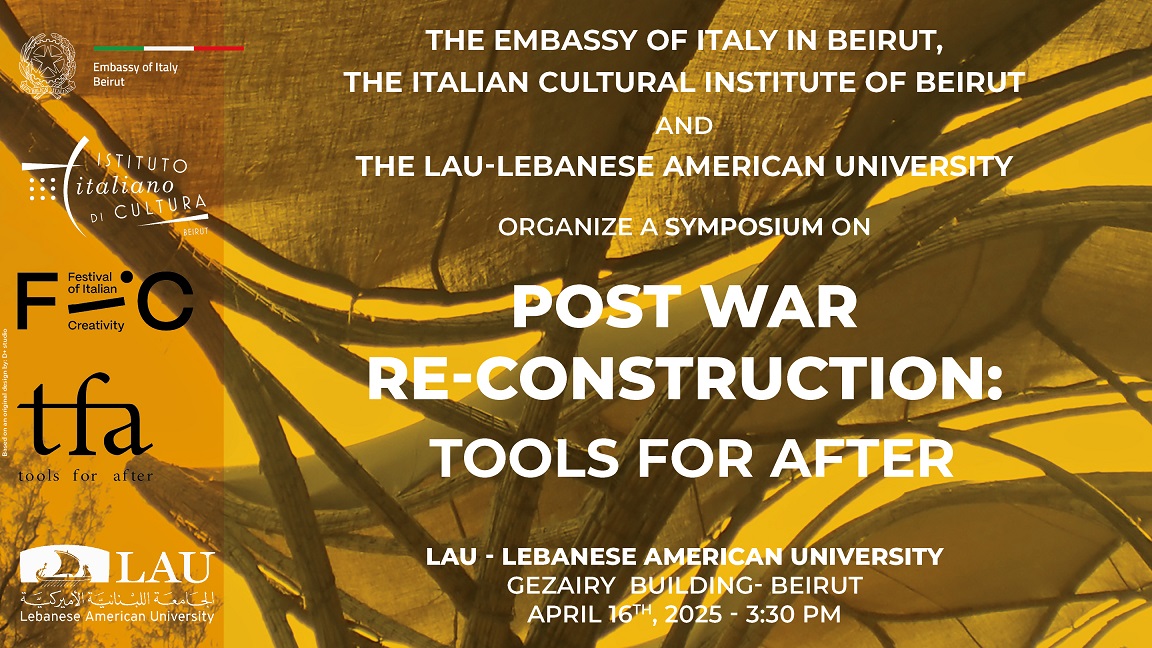The Embassy of Italy in Beirut, the Italian Cultural Institute of Beirut, in partnership with the School of Architecture & Design at the Lebanese American University, are organizing a symposium and accompanying exhibition on the overarching theme Post-War Reconstruction: Tools for After, to be held on April 16, 2025, at the Gezairi Building, LAU Beirut campus.
The recent post-war destruction in Lebanon has compelled a renewed critical examination of the spatial and material constituents of our built environment—particularly within the most severely affected areas. These urban and architectural layers not only narrate the historical trajectories of place, but are also deeply embedded in the socio-economic and cultural fabric of the territory. Within this framework, the ruins themselves become a lens through which to articulate contemporary visions for recovery, grounded in sustainable and context-responsive methodologies.
This symposium seeks to investigate alternative ecological, natural, and biotechnological materials as part of a broader cultural shift toward sustainable construction and rehabilitation practices. The objective is to explore the potential reactivation of existing public structures through the integration of new functions and innovative materials, thereby contributing to the formation of a cohesive urban strategy rooted in a contemporary and sustainable design ethos.
By interrogating the historical, social, and architectural value of these urban fragments, the initiative aims to foreground the complex layers of post-war reconstruction. It proposes new tools and thematic frameworks to stimulate the regeneration of public spaces and catalyze a critical dialogue on the future of urban resilience.
The symposium will see the participation of various architects and designers – or their representatives – who will illustrate their innovative projects, in person or via live video connection. They will present alternative, ecological, natural, and biotechnological materials for an effective and possible building culture, ranging from the ancient art of construction to projects for human environments on other planets.
The Symposium will start with a live video conference on Space Architecture projects, presented by Valentina Sumini, Visiting Professor at Politecnico di Milano and Space Architect and Engineer Research Affiliate at MIT Media Lab within Space Exploration Initiative and Responsive Environments. Her passion in advancing human performance during deep space exploration mission dates back to 2009 when she designed for the first time a hotel on the lunar surface, named Moorea. Sumini generates innovative design, architecture and engineered solutions through a holistic approach in order to sustain human life in extreme environments on Earth and enable human space exploration in Low Earth Orbit, on the Moon and Mars.
The audience will also have the opportunity to explore sustainable mobility and architectural research – presented by Virginia Corbisiero – through the renowned works of Massimo Iosa Ghini, who has designed the Marconi Express project connecting Bologna airport with the railway station using electric mobility powered by solar panels along the route.
Architect Selenia Marinelli‘s work will exemplify the intersection between biological and architectural systems, focusing on the application of bioplastics in architecture.
For the Geologika Collettiva group, Barbara Narici will showcase raw earth constructions and Maddalena Ferraresi will illustrate the usage of straw in construction. Both are building materialas lauded for their eco-sustainable qualities.
Additionally, the exhibition will introduce the innovative construction method named CanyaViva, which utilises marsh reeds (Arundo Donax) developed by artists Margherita Bertoli from Arundo Art and Matteo Mannini from Canya Lab, presented by Cristina Setti.
Last but not least, the audience will witness the use of bamboo as a building material by the pioneering Italian-Colombian architect Mauricio Cardenas Laverde.




